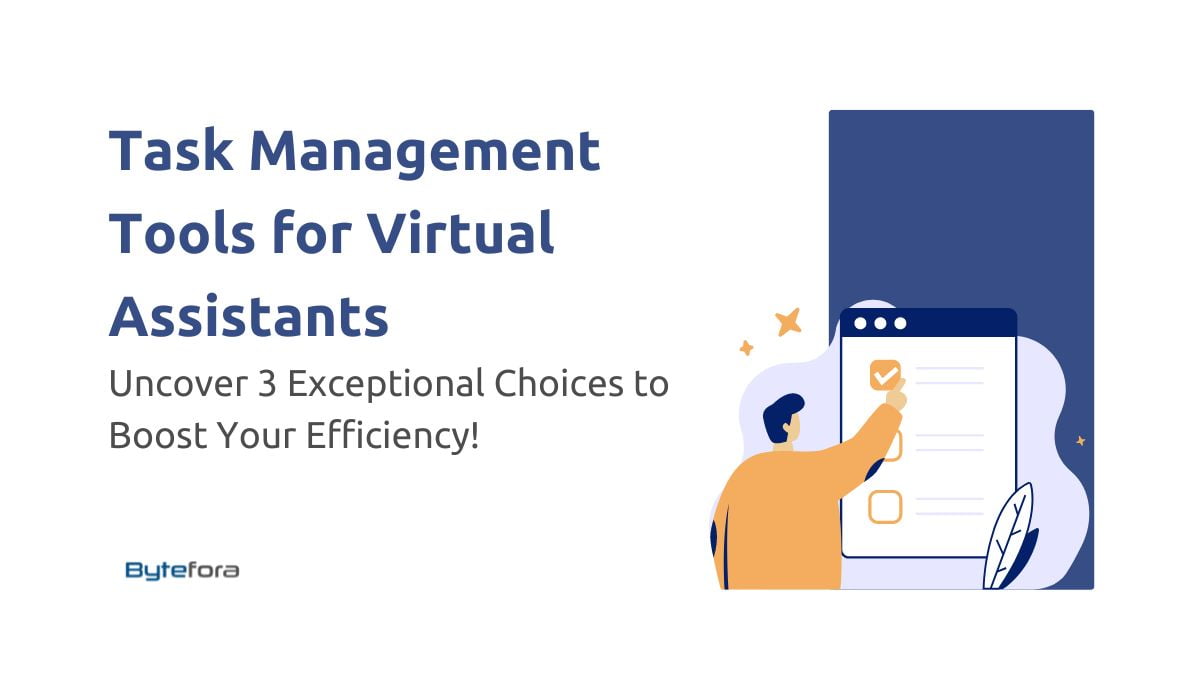Are you a virtual assistant looking to improve efficiency and streamline workflow? Discover the transformative power of task management tools specifically designed for virtual assistants. In this dynamic and fast-paced digital era, staying organized and managing tasks effectively is crucial for success. Delve into our comprehensive guide, where we explore the best task management tools available – Asana, Monday.com, and Trello. Each offers unique features to enhance productivity and cater to the diverse needs of virtual assistants. Join us as we unravel these exceptional tools that promise to revolutionize your approach to task management and boost your professional efficiency!
Table of Contents
1. Asana

What Is Asana?
At its core, Asana is a sophisticated web-based task management and collaboration tool meticulously crafted to keep businesses on track by managing crucial tasks within defined timeframes. Its prowess lies in providing a holistic solution for efficiently organizing, collaborating, planning, and executing tasks. The platform has garnered trust and adoption globally, with esteemed companies like Deloitte, Airbnb, Pinterest, and Dropbox relying on its capabilities. Asana’s reach extends to 195 countries, exemplifying its universal appeal and adaptability.
It has established a strong reputation in user satisfaction, with a rating of 8.5 out of 10 on TrustRadius, reflecting its effectiveness in value for money (4.3/5), ease of use (4.7/5), and customer support (4.5/5), according to Techjockey.
How Does It Work?
- Workspaces: Collaborative Havens: – Asana introduces workspaces and shared environments where users seamlessly collaborate on tasks and projects. These workspaces serve as the foundation for tailored organization, ensuring that teams can structure their collaborative efforts in a manner conducive to productivity.
- Projects: Units of Organization: – Projects, both private and public, form the backbone of Asana’s organizational structure. They offer a canvas for color-coded and filtered project management, providing teams with a visual and intuitive interface to navigate and prioritize their work effectively.
- Tasks: Building Blocks of Productivity: – Tasks, the elemental components within Asana, allow individuals and teams to break down extensive work into manageable units. These to-dos can be enriched with diverse information, empowering users to balance workloads and maintain clarity regarding the objectives of each task.
- Calendar: Dynamic Task Visualization:- A key feature of Asana is its calendar, which offers dynamic visualization of pending tasks. Users can seamlessly switch between list and calendar views, adding a layer of flexibility to their approach to task management.
Features That Elevate
I. Communication Tools: – Asana’s communication tools are epitomized by its inbox feature. This centralized hub facilitates the tracking of messages and associated tasks. Users can attach tasks to messages and even proof photographs and PDFs, creating a streamlined communication process within the platform.
II. Different Ways To View Work: – Recognizing the diversity in work styles, Asana offers multiple viewing options. These include List, My Tasks, Calendar, Board, Inbox, and Files, providing users with the freedom to choose the format that aligns with their workflow preferences.
III. Management and Reporting Tools: – Asana goes beyond basic task management by providing robust tools for project organization and reporting. Managers can harness reporting tools to organize project updates, set goals, and track milestones effectively. Status updates, dashboards, and portfolio views offer quick and insightful glimpses into project progress.
IV. Easy App Integration: – Asana prides itself on its seamless integration capabilities with various apps, enhancing its functionality. Integration options span popular tools like Power BI, Microsoft Teams, Zoom, Outlook, Gmail, and Slack for communication, along with Adobe Creative Cloud, OneDrive, Office365, Box, Google Drive, and Dropbox for file creation and sharing.
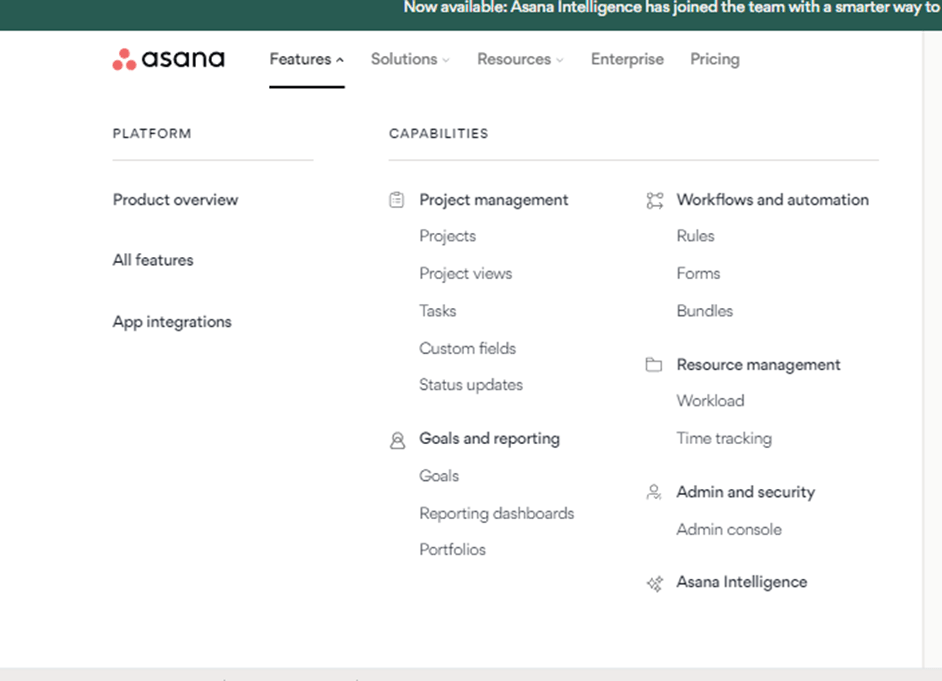
The Pros and Cons
I. Pros:
- Attractive Interface Design: – The high quality and intuitive design of Asana’s interface is one of the company’s most distinguishing features. This contributes not only to a positive user experience but also to adoption and engagement.
- Easy-to-Use Calendar Functionality:-The integration of an easy-to-use calendar stands out as a notable advantage. It provides users with a centralized view of upcoming deadlines and milestones, fostering proactive task management and time-sensitive decision-making.
- Centralized View of Personal Tasks: – Asana offers users a centralized view of their personal tasks. This feature enhances individual productivity by providing clarity and a consolidated perspective on pending assignments.
- Robust Communication Tools: – The communication tools within Asana, especially the inbox feature, prove to be robust and efficient. They facilitate seamless communication and collaboration among team members, contributing to a cohesive work environment.
II. Cons:
- Challenges in Tracking Items Across Multiple Projects: – One notable challenge users may encounter is the difficulty in tracking items across multiple projects, especially when dealing with similar due dates. This aspect requires careful consideration to avoid potential oversights.
- Structures are Prone to Breaking: – There is a potential risk associated with the platform’s structure, where it may be prone to breaking or tasks being unintentionally removed or renamed. This emphasizes the importance of meticulous management and oversight.
- Limitations in Assigning Multiple People to the Same Task: – Asana presents a limitation when it comes to assigning multiple people to the same task. While this might be a minor issue for some projects, certain collaborative endeavors may find this limitation restrictive.
- Potential Slowdown with an Extensive Number of Tasks: – A performance-related concern with Asana is the potential slowdown when handling an extensive number of tasks. This aspect necessitates strategic task management to maintain optimal platform performance.
Pricing Plan
The project management tool Asana offers a variety of pricing plans to meet the needs of individuals, small teams, growing businesses, and large organizations. Asana’s pricing structure is broken down below, along with its benefits and features.
Personal (Free)
- · Target Audience: Individuals and small teams
- · Pricing: US$0 (Free forever)
- · Key Features:
- Unlimited project management essentials
- Ideal for personal task management and small-scale collaboration
- No cost, providing access to Asana’s core features
- No credit card is required for sign-up
Starter
- Target Audience: Growing teams tracking project progress
- Pricing:
- US$10.99 per user per month (billed annually)
- US$13.49 per user, per month (billed monthly)
- Key Features:
- Build on the essentials with additional team and project management features
- Suitable for teams looking to enhance collaboration and hit project deadlines
- Offers a cost-effective solution for expanding teams
Advanced
- Target Audience: Companies managing a portfolio of work across departments
- Pricing:
- US$24.99 per user per month (billed annually)
- US$30.49 per user, per month (billed monthly)
- Key Features:
- Comprehensive features for managing complex work and goals
- Enhanced portfolio management capabilities
- Suitable for businesses seeking advanced project tracking and reporting

Enterprise
- Target Audience: Companies requiring coordination and automation of complex work
- Pricing: Custom pricing, contact Asana sales for a quote
- Key Features:
- Tailored solutions for enterprise-level project management
- Advanced security and administrative controls
- Ideal for large organizations with diverse project requirements

Project management tool Asana stands out for its attractive interface, effective communication tools, multiple viewing options, and robust reporting features. While Asana is not immune to challenges, like tracking items across multiple projects and possible structural issues, it remains a popular choice for teams aiming to enhance collaboration and task management. For organizations to maximize its benefits within their unique operational contexts, understanding its strengths and limitations is critical. Its enduring appeal is in its ability to adapt to the ever-changing needs of modern businesses, providing a reliable platform for managing projects efficiently.
2. Monday.com
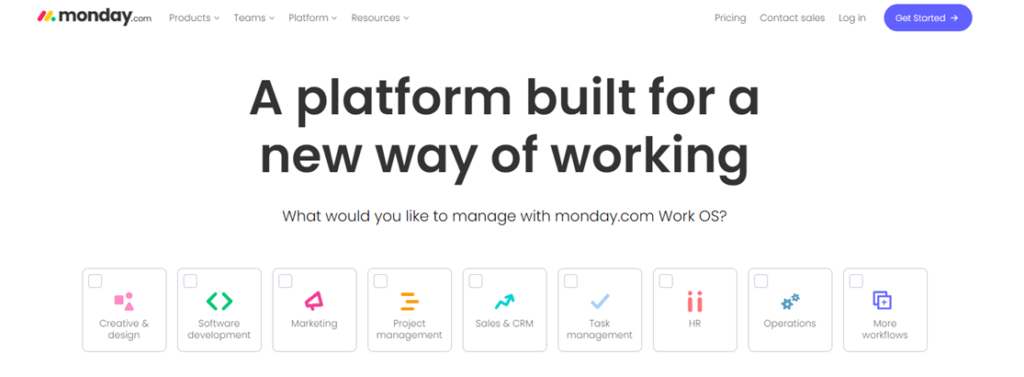
What is Monday.com?
Monday.com is a robust work operating system utilized by software development, marketing, human resources, and operations teams. It transcends industry boundaries, offering a flexible and universal platform that can be tailored to meet the specific requirements of different sectors. The platform’s broad clientele attests to its universal appeal and effectiveness in enhancing collaboration and productivity.
Reinforcing its position, Monday.com has earned a top-rated score of 8.4 out of 10 on Trustradius, with over 4,572 reviews and ratings. It’s particularly praised for its ease of use (4.5/5), customer support (4.5/5), value for money (4.5/5), and overall functionality (4.5/5), as evidenced by various software review platforms. These accolades highlight Monday.com’s ability to provide a versatile task management solution for virtual assistants and businesses.
How to Utilize Monday.com for Effective Project Management
- Organization: – Monday.com excels in facilitating efficient project organization through various features. Customizable planning sheets, cost calculators, collaborative task assignments, and accessible bi-directional communication are vital components that contribute to the effective structuring of projects.
- Management Solutions: – The platform offers tools that enhance communication, collaboration, project monitoring, and budget adherence. This not only streamlines project workflows but also aids teams in reducing project time and costs, contributing to overall efficiency.
- Data and Visualization: – Monday.com provides project dashboards designed for visualizing goals, tasks, budgets, and schedules, and providing insightful data for informed decision-making. This emphasis on data and visualization empowers teams to make strategic decisions established on a clear understanding of project dynamics.
- Abundance of Features: – Monday.com boasts a rich set of features that contribute to its significance in project management. From customizable templates to planning dashboards, the platform enables collaboration, supports role assignment, facilitates deadline-setting milestone creation, and ensures clear project clarity.
Features:
Monday.com includes the following standout features:
- Customizable Planning Sheets: Tailor your planning sheets to match your project’s unique requirements.
- Cost Calculators: Effectively manage project budgets with built-in cost calculation tools.
- Collaborative Task Assignments: Streamline task assignments through collaborative efforts among team members.
- Bi-directional Communication: Foster seamless communication with a bidirectional flow of information.
Pros and Cons:
I. Pros:
- Versatility: Monday.com caters to a wide array of industries and tasks, showcasing its adaptability across different business domains.
- Central Hub Functionality: Serving as a centralized platform, it provides teams with a dedicated space to strategize, coordinate, and collaborate effectively.
- Positive Customer Reviews: Endorsements from satisfied users highlight the platform’s success and user satisfaction.
II. Cons:
- Learning Curve: Implementing Monday.com may pose a challenge initially, requiring some time for teams to fully grasp its capabilities.
- Pricing Considerations: While offering powerful features, the pricing structure might be prohibitive for certain businesses, necessitating careful consideration.
Pricing Plans
Unlock the full potential of collaboration and organization with Monday.com’s versatile pricing plans. Whether you’re a small team or a large enterprise, Monday.com has a solution tailored to meet your unique needs.
Free Plan – Monthly:
- Price: $0 per month
- Seats: Up to 2
- Billing: Free forever
- Features:
- Unlimited boards and workflows
- No credit card is needed
- Yearly subscription available with an 18% discount
Basic Plan – Billed Annually:
- Price: $8 per seat per month
- Total: $24 per month (Billed annually)
- Features:
- All features from the Free Plan
- Ideal for small teams
- Additional capabilities to enhance collaboration
Standard Plan – Most Popular – Billed Annually:
- Price: $10 per seat per month
- Total: $30 per month (Billed annually)
- Features:
- All Basic Plan features
- Perfect for growing teams
- Comprehensive tools for efficient project tracking and management
Pro Plan – Billed Annually:
- Price: $16 per seat per month
- Total: $48 per month (Billed annually)
- Features:
- All Standard Plan features
- Advanced functionalities for larger teams
- Enhanced customization options for workflows
Enterprise Plan – Contact us:
- Price: Customized for enterprise needs
- Features:
- Tailored for organizations seeking enterprise-grade features
- Advanced security controls
- Dedicated support and onboarding assistance
Additional Information:
- Monthly Free Plan: Enjoy the flexibility of the Free Plan on a monthly basis with no long-term commitment. Ideal for individuals and small teams exploring Monday.com’s capabilities.
- Yearly Subscription Discount: Opt for the yearly subscription on the Free Plan and enjoy an 18% discount. Make significant savings while harnessing the power of unlimited boards and workflows.
- Enterprise Customization: Contact Monday.com directly for a personalized quote based on your enterprise requirements. Benefit from advanced features, robust security controls, and dedicated support tailored to your organization’s scale and needs.
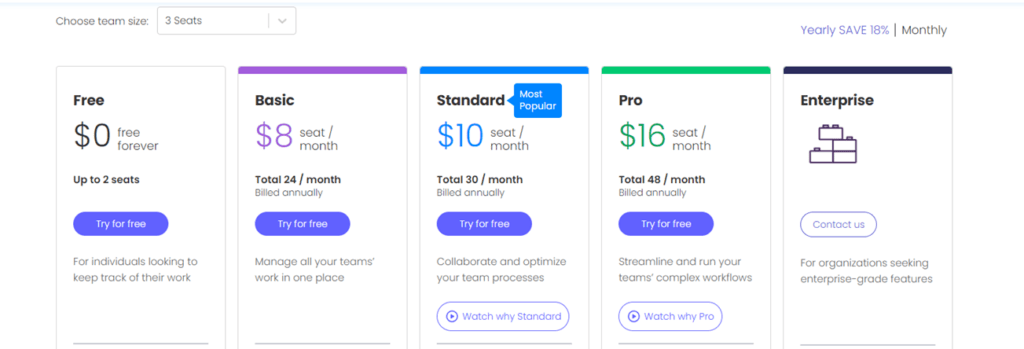
Whether you’re just starting out or want to boost collaboration, Monday.com’s plan is perfect for you. Sign up for a free account or check out the premium plan to boost productivity and streamline workflows. No matter your organization, Monday.com can help you elevate your teamwork to new heights.
Monday.com emerges as a powerhouse in project management, offering versatility, a central hub for collaboration, and garnering positive feedback from users across industries. Its strengths lie in its ability to cater to diverse use cases and provide a centralized space for effective team coordination. However, businesses should be mindful of the potential learning curve during implementation and carefully consider the pricing implications based on their specific requirements. As organizations seek a robust solution for streamlined project management, Monday.com stands out as a reliable choice with the potential to drive success across varied teams and industries.
3. Trello
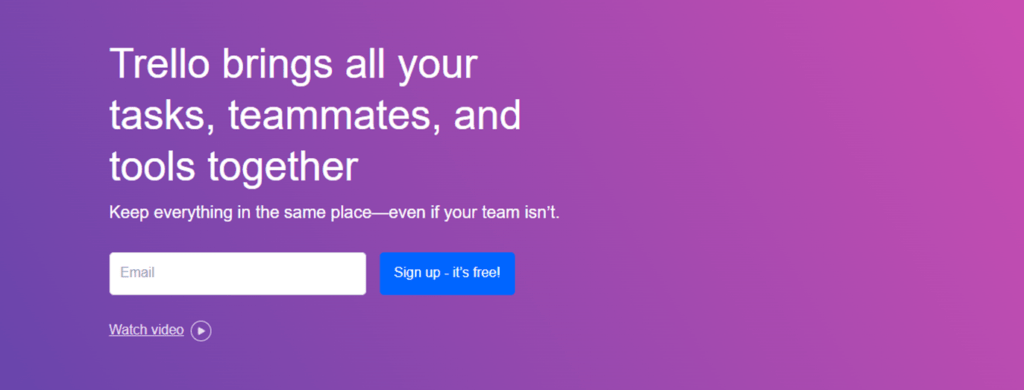
What is Trello?
Trello is a popular collaboration tool designed to simplify project organization and management. As one of the leading collaborative platform applications, Trello enables users to organize their work using boards, cards, and lists. It is an intuitive platform catering to many users, from individuals to large teams and organizations.
Additionally, Trello is renowned for its user-friendly interface and versatile task management capabilities, boasting a ‘great’ User Satisfaction Rating of 89% based on 35,053 user reviews from five recognized software review sites. This high rating underscores Trello’s effectiveness in simplifying project tracking and management, making it a favorite among virtual assistants and teams seeking an intuitive and flexible tool for their workflow needs.
Key Features
- Boards, Cards, and Lists: Trello’s foundation is built upon three main components – boards representing projects, cards for individual tasks, and lists for task categorization. This structure allows for a clear and visual representation of project workflows.
- Checklists: Within each card, users can create checklists to organize subtasks efficiently. This feature enhances the granularity of task management, ensuring that every aspect is accounted for.
- Members and Notifications: Tasks can be assigned to multiple team members, facilitating collaboration. Notifications are automatically sent for any changes made to cards, keeping everyone in the loop.
- Deadlines: Tasks can have associated deadlines, promoting effective time management and assuring that projects stay on track.
- Attachments: Users can attach files and documents directly to cards, providing a centralized location for all project-related resources.
- Automation (Butler): Trello incorporates an automation tool called Butler. This feature automates repetitive tasks, saving time and reducing manual efforts.

How to Use It:
1. Sign up on Trello: Users can easily sign up on Trello’s website to create a new board and begin their project management journey.
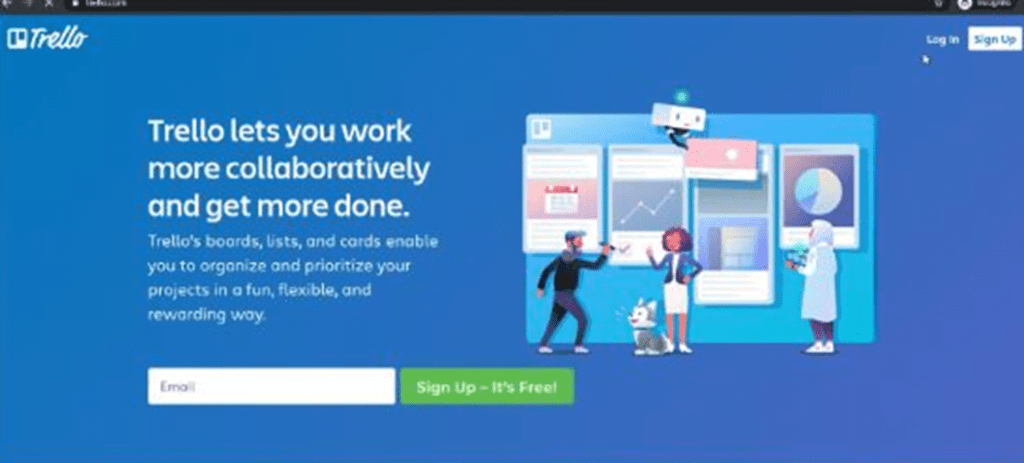
2. Create a Board: Boards serve as the central hub for projects. Trello allows customization options to tailor boards according to specific project needs.

3. Create a Team: For professional collaboration, users can set up a team, inviting members to join Trello. This ensures seamless teamwork and communication.

4. Create Lists: Lists represent different project steps, such as To Do, In Progress, On-hold, and Completed. These lists aid in organizing tasks effectively.

5. Create Cards: Cards within lists represent individual tasks. Users can add detailed descriptions, checklists, due dates, attachments, and labels to each card.

6. Assign Members and Due Dates: Assigning team members to cards keeps everyone informed about their responsibilities, and due dates ensure effective tracking of task completion.

7. Add Labels to Cards: Labels help categorize cards based on task type or group, providing a visual aid for organized project management.
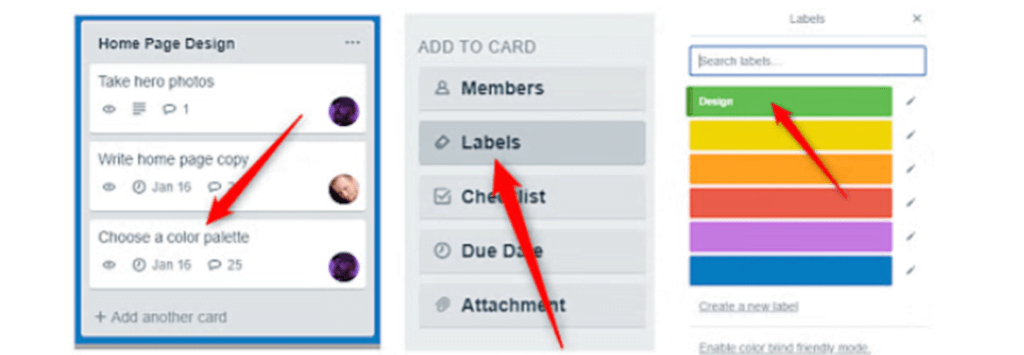
8. Search with Shortcuts: Trello offers keyboard shortcuts for efficient searching, filtering, and navigation. This enhances the overall user experience, especially for those who prefer shortcut commands.
Trello Advantages
- Immediate Usability: Trello offers immediate usability with a free sign-up option. Users can quickly grasp the platform’s fundamentals, making it available to a wide range of users.
- Adherence to the Kanban System: Trello follows the Kanban system, promoting lean management and visualizing workflow. This approach simplifies project tracking and enhances efficiency.
- Mobile-Friendly Interface: The mobile-friendly interface ensures that users can manage and track their projects on the go, fostering flexibility and accessibility.
- All-In-One Project Visibility: Trello provides a single-page view of all project-related information. This centralized approach aids in keeping teams aligned and informed.
5. Easy Addition of Members and Task Assignment: The platform facilitates the seamless addition of team members and assignment of tasks. This promotes collaboration and ensures that everyone is on the same page.
Pros and Cons
I. Pros:
- Limitless Use Cases: Trello is versatile and applicable across various industries, accommodating different project management needs.
- Central Hub for Diverse Needs: Acting as a central hub, Trello caters to diverse project requirements, making it appropriate for a wide range of applications.
- Positive Customer Reviews: Trello enjoys positive feedback from users who appreciate its simplicity, flexibility, and effectiveness in project management.
II. Cons:
- Learning Curve for Some Users: While Trello is designed for immediate usability, some users may experience a learning curve, especially when exploring cutting-edge features.
- Pricing Considerations: The pricing structure might be a constraint for some businesses, particularly if they require features available only in paid plans.
- Limited Time-Tracking Features on Standard Plans: Standard plans may have limitations in terms of time-tracking features, which could be a drawback for users who prioritize detailed time management.
Trello’s simplicity and flexibility position it as a go-to choice for many users. Adhering to the Kanban system, offering a mobile-friendly interface, and supporting various integrations contribute to its popularity. While it may have a learning curve for some, Trello’s positive attributes make it a compelling solution for effective project management. As teams continue to seek collaborative tools that balance ease of use with robust features, Trello remains a frontrunner in simplifying collaboration with its intuitive boards and card structure.
Pricing Plan:
Trello, a trusted collaboration tool used by millions globally, offers a range of pricing plans to cater to diverse team needs. Whether you’re a small team looking for basic project management or an enterprise seeking advanced features and heightened security, Trello has a pricing tier to suit your requirements. Let’s explore the available options:
Free Plan
- Cost: $0 USD
- Description: The Free plan is designed for teams that want to enjoy the benefits of Trello without any financial commitment. It provides essential features for your entire team at no cost.
Standard Plan
- Cost: $5 USD per user/month if billed annually ($6 billed monthly)
- Description: The STANDARD plan is tailored for small teams aiming to manage their work efficiently and scale collaboration. With a cost-effective per-user pricing model, it offers more features than the Free plan.
Premium Plan
- Cost: $10 USD per user/month if billed annually ($12.50 billed monthly)
- Description: The PREMIUM plan is ideal for teams that require advanced functionalities such as tracking and visualizing multiple projects using boards, timelines, calendars, and more. It provides a comprehensive solution for enhanced project management.
Enterprise Plan
- Cost: $17.50 USD per user/month – billed annually ($210.00 annual price per user)
- Description: The ENTERPRISE plan is designed for organizations that need a robust platform to connect work across teams with added security and controls. It offers features suitable for large-scale, complex collaboration.
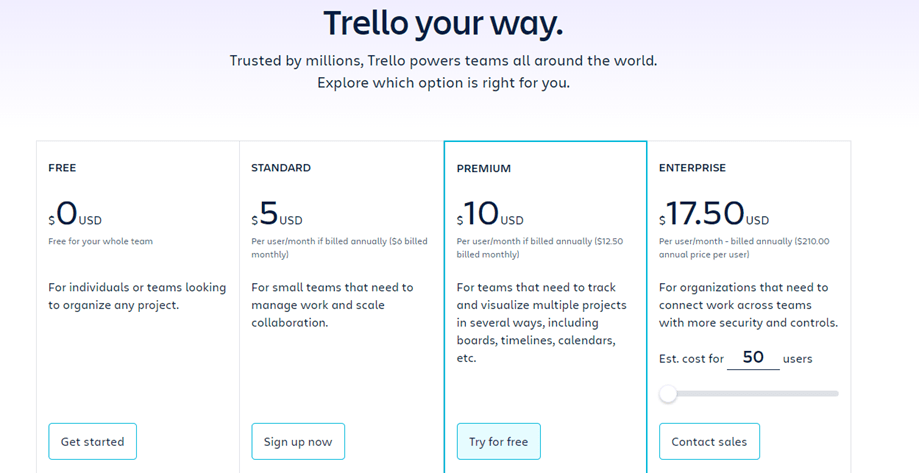
Trello’s pricing structure allows teams of varying sizes and needs to tailor their collaboration experience. Whether you’re on a budget-conscious journey or require an enterprise-grade solution, Trello’s pricing plans empower you to choose the level of functionality and features that align with your team’s goals. Explore the options and supercharge your teamwork with Trello
Conclusion: Harnessing the Power of Task Management Tools for Virtual Assistants
In conclusion, the journey through the world of task management tools for virtual assistants brings us to a crucial decision point. As we’ve seen, Asana, Monday.com, and Trello each offer unique functionalities and benefits that cater to different working styles and project needs. As a virtual assistant, your choice of tool can significantly influence your efficiency and output quality.
Asana stands out for those who thrive in a detailed and structured environment, offering comprehensive project management capabilities. Trello is the go-to choice for those who prefer a more intuitive and visually oriented system, simplifying project tracking and management. Meanwhile, Monday.com shines with its flexibility and customization options, making it ideal for virtual assistants handling diverse projects.
Now, it’s your turn to take the reins. Assess your specific needs, the nature of your tasks, and the type of collaboration you engage in. Choose the task management tool that aligns best with your workflow, and watch as it transforms your efficiency and effectiveness as a virtual assistant. Remember, the right tool is more than just a software application; it’s a partner in your professional excellence and success journey. So, embrace the power of these task management tools and propel your virtual assistant career to new heights!
Additional Resources
While exploring task management tools, it’s also beneficial to consider the broader spectrum of cloud productivity software. For a deeper understanding of how these tools can complement your task management strategies, check out this insightful article: Cloud Productivity Software Insight.

